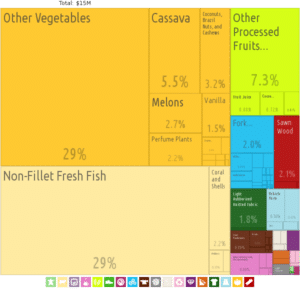
The tourist industry is relatively undeveloped; however, the government recognizes that tourism can play a major role in economic development, and efforts are being made to increase this source of revenue. Cruise ships often stop in Vavaʻu, which has a reputation for its whale watching, game fishing, surfing, beaches and is increasingly becoming a major player in the South Pacific tourism market.
Tonga’s postage stamps, which feature colorful and often unusual designs (including heart-shaped and banana-shaped stamps), are popular with philatelists around the world.
In 2005, the country became eligible to become a member of the World Trade Organization. After an initial voluntary delay, Tonga became a full member of the WTO on 27 July 2007.
Transportation:
Transport in Tonga includes road, air and water-based infrastructure. There are 680 km of highways in Tonga, of which 184 km are paved, and there are a number of air and seaports.
There are three harbours in Tonga: Neiafu, Nukuʻalofa and Pangai, and in terms of merchant marine, the country possesses seven ships that exceed 1,000GT, whose masses combined total 17,760GT. By type, there is one bulk ship, two cargo ships, two liquefied gas ships, one petroleum tanker and roll-on/roll-off ship.

By 1999 estimates, there are six airports in Tonga. Of these, only Fuaʻamotu International Airport on Tongatapu has paved runways. Of the remaining airports, one has runways exceeding length 1,524 m, two have runways longer than 914 m, with the remaining two having runways shorter than 914 m.
Flag of Tonga:
The flag of Tonga consists of a red field with a white canton charged with a red couped cross. Adopted in 1875 after being officially enshrined into the nation’s constitution, it has been the flag of the Kingdom of Tonga since that year. The constitution stipulates that the national flag can never be changed.
The British first arrived in Tonga in the late-18th century, when Captain James Cook made three visits to the islands between 1773 and 1777. Approximately fifty years later, English Wesleyan Methodist missionaries came to Tonga and began converting the islanders to Christianity. In 1831, they succeeded in converting “paramount chief” Taufa’ahau Tupou, who became King George Tupou I in 1845. It was during this time (circa 1840s) that the first Tongan flag was adopted. It consisted of a white field with a cross (either red or blue in colour) at all four corners, and the letters “A” (in red) and “M” (in blue) at the center that symbolize the king.

Upon his accession to the throne, the king sought to design a new flag for the nation, one that would represent Christianity. He befriended Shirley Waldemar Baker – a member of the United Kingdom’s Tongan mission who later became the Prime Minister of Tonga – and they worked together to formulate a new flag, coat of arms and national anthem for Tonga. The new design resembled the British Red Ensign, in that three-quarters of it consisted of a simple red field, with a “distinctive canton” featured in the upper hoist section; this was first used in 1866. A new constitution for the kingdom was formulated and proclaimed on 4 November 1875. It codified the new flag design, and marks when it was adopted as the national flag. Under Article 47 of the Constitution, the flag can “never be altered” and “shall always be the flag” of Tonga.
